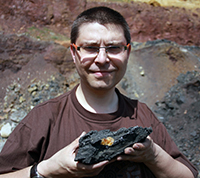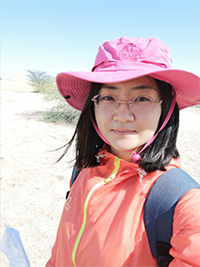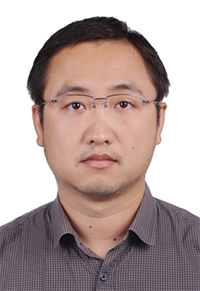 Thierry Bourgoin. Institut Systématique, Evolution, Biodiversité (ISYEB), UMR 7205 MNHN-CNRS- Sorbonne Université-EPHE, Museum National d'Histoire Naturelle, CP50, 57 rue Cuvier, 75005, Paris, France. Co-corresponding author. thierry.bourgoin@mnhn.fr
Thierry Bourgoin. Institut Systématique, Evolution, Biodiversité (ISYEB), UMR 7205 MNHN-CNRS- Sorbonne Université-EPHE, Museum National d'Histoire Naturelle, CP50, 57 rue Cuvier, 75005, Paris, France. Co-corresponding author. thierry.bourgoin@mnhn.fr
ORCID 0000-0001-9277-2478
Thierry Bourgoin is Professor at Museum national d’histoire naturelle of Paris France in the research unit UMR 7205, the LIS team (Lab. Info. & Syst.). He studies planthoppers biodiversity (Insecta Hemiptera Fulgoromorpha) as a model for his research in evolution. His main focuses are morphological disparity and taxonomy in both actual and fossil taxa, molecular phylogeny and, using this evolutionary framework, biogeography and planthopper interspecific relationships. Field researches are mainly around Indian Ocean. He is also interested in the formalisation, synthesis and visualisation of taxonomic knowledge and he manages since 1997 the database FLOW (https://www.hemiptera-databases.org/flow/), a knowledge base and global systematic database about planthoppers (15K species, 30K names).

 Rong-Rong Wang. Institute of Zoology, Chinese Academy of Sciences, 1 Beichen West Road, Chaoyang District, Beijing 100101, P.R. China. Co-corresponding author. rongrong@ioz.ac.cn
Rong-Rong Wang. Institute of Zoology, Chinese Academy of Sciences, 1 Beichen West Road, Chaoyang District, Beijing 100101, P.R. China. Co-corresponding author. rongrong@ioz.ac.cn
ORCID 0000-0002-9667-2738
Rongrong Wang received her Ph.D. at Institute of Zoology, Chinese Academy of Sciences. Her research interests cover taxonomy, morphology, diversity, biogeography and evolution of planthoppers (Hemiptera: Fulgoromorpha). Her main focuses are taxonomic and phylogenetic studies of Hemiptera Tropiduchidae and their relatives, to reconstruct the phylogeny and shed light on their evolutionary scenarios.

 Jacek Szwedo. Laboratory of Evolutionary Entomology and Museum of Amber Inclusions, Department of Invertebrate Zoology and Parasitology, University of Gdańsk, 59 Wita Stwosza Street, 80-308 Gdańsk, Poland. jacek.szwedo@biol.ug.edu.pl
Jacek Szwedo. Laboratory of Evolutionary Entomology and Museum of Amber Inclusions, Department of Invertebrate Zoology and Parasitology, University of Gdańsk, 59 Wita Stwosza Street, 80-308 Gdańsk, Poland. jacek.szwedo@biol.ug.edu.pl
ORCID 0000-0002-2796-9538
Jacek Szwedo received his M.Sc. (1990) and Ph.D. (1997) at University of Silesia in Katowice, and his habilitation dissertation he defended at the Museum and Institute of Zoology, Polish Academy of Sciences in Warsaw (2013). He used to work at Department of Zoology, University of Silesia in Katowice, Museum and Institute of Zoology, Polish Academy of Sciences in Warsaw, and since 2014 at the Department of Invertebrate Zoology and Parasitology, University of Gdańsk. Since May 2017 he is Head of Laboratory of Evolutionary Entomology and Museum of Amber Inclusions, University of Gdańsk. His research interests cover evolution, taxonomic diversity and morphological disparity, systematics and distribution of the Hemiptera, particularly Fulgoromorpha and Cicadomorpha, and their relatives. He is studying inclusions in amber, rock-preserved fossils, as well as modern representatives of the hemipterans, to recover their morphology, phylogeny, taxonomy, evolutionary and biogeographical scenarios, palaeoecology and palaeobiodiversity.

 Xin-Yu Li. College of Nature Conservation, Beijing Forestry University, Beijing 100083, P. R. China. 136179665@qq.com
Xin-Yu Li. College of Nature Conservation, Beijing Forestry University, Beijing 100083, P. R. China. 136179665@qq.com
ORCID 0000-0001-5136-0303
Xinyu Li is a double-degree PhD candidate enrolled in both Beijing Forestry University and University of Copenhagen. She received her M.Sc. (2014) and then got her master and PhD projects successively at BFU. Her interests include taxonomy, morphology and evolutionary radiation of insects, especially hemipteran planthoppers and dipteran calyptrates. Three dimensional visualization of morphological characters holds her interest as well.

 Xi Chen. Institute of Automation, Chinese Academy of Sciences, 95 Zhongguancun East Road, Haidian District, Beijing 100190, P.R. China. xi.chen@ia.ac.cn
Xi Chen. Institute of Automation, Chinese Academy of Sciences, 95 Zhongguancun East Road, Haidian District, Beijing 100190, P.R. China. xi.chen@ia.ac.cn
ORCID 000-0002-6922-2838
Xi Chen received his B.S. degree in Electronic and Information Engineering from Xi'an Jiaotong University, Xi’an, China, in 2004, and Ph.D. degree in Pattern Recognition and Intelligent Systems from Institute of Automation, Chinese Academy of Sciences, Beijing, China, in 2009. He is currently an associate professor in Institute of Automation, Chinese Academy of Sciences. His current research interests include image registration, pattern recognition, and using these methods for volume reconstruction of biological tissue from serial section microscopic images.

